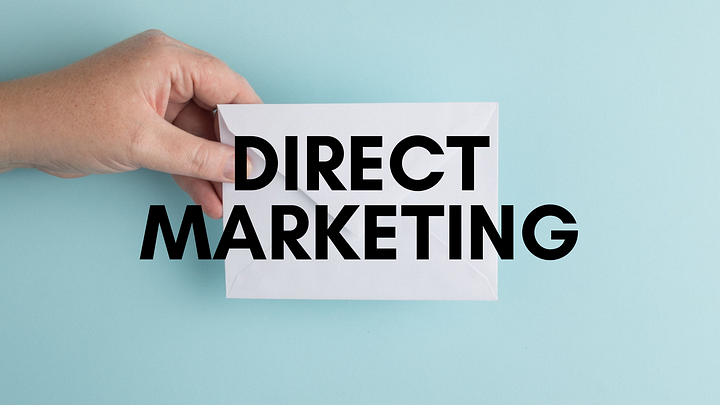
Mass marketing is inefficient and expensive. Would it not be great if you could cut out the middleman and advertise to customers direct? The good news is, you can!
Direct marketing uses advertising tactics such as email marketing, mail drops and paid ads online to reach customers with targeted marketing messages.
This article explores direct marketing, explaining how it works and the different direct marketing tactics that businesses can use to reach customers.
“Retailers use direct marketing as one marketing communication tool in their overall communication portfolio to reach existing customers. (Uematsu, & Mishra, 2011)
What is direct marketing?
There are two main advertising variants to a marketing strategy — mass marketing and direct marketing.
Mass marketing uses mass media such as television, radio, and newspapers to broadcast messages to random publics.
Direct Marketing is advertising that seeks to achieve a specific action from a selected target audience of the most likely buyers.
The use of direct marketing has grown considerably in the digital era, as the cost of collecting and storing customer data has reduced. An increase in distribution channels’ available online provides direct access to the customer.
As the name implies, communication and/or distribution is direct with the consumer, bypassing a third party such as the mass media.
Types of direct marketing include:
- Email marketing
- Direct mail
- Fliers
- Brochures
- Couponing
- Catalogue distribution
- Postcards
- Promotional letters
- Loyalty cards
- Insert media
- Couponing
- Door-to-door sales
- Telemarketing phone calls
- Text messaging
- Messenger
- Websites
- Social media
- Targeted online ads
There is some disagreement about whether some forms of promotion are direct marketing.
Some marketers consider television infomercials, newspapers and magazine advertisements, and outdoor advertising direct marketing. But only if it has a direct response aspect, such as a toll-free number.
However, these marketing methods are not as targeted as most direct marketing forms, so I do not include them here.
Most of these direct marketing methods are explained later in the document.
The objectives of direct marketing
Direct marketing campaigns aim to persuade consumers to action, providing tangible and measurable results, such as purchases, signups, or requests for more information.
While other advertising methods such as content marketing aims to educate prospects rather than sell, direct marketing intends to encourage a specific action.
Some of the reasons for using direct marketing are:
- Improve sales of specific products
- Clear discontinued stock
- Increase customer retention and loyalty
- Follow up on promotional offers.
A call to action
Direct marketing commonly uses incentive-based information where it offers consumers a benefit to act on. Called a call to action (CTA), they depend on your industry and the target consumers.
Examples of CTAs are:
- Click the link
- Visit our website or store
- Call us to get more info on our products or services
- Subscribe with your email address
- Purchase here
- Register your interest
- Limited-time coupon
- Sign up now
- Invitation-only event
- Discounted membership
- Make a booking

The benefits of using direct marketing
There are several benefits to businesses using direct marketing. I will talk about some of those now.Marketing is measurable
The first significant benefit of direct marketing is clearly measurable results.
Direct marketing is more straightforward to measure than many other types of advertising. With a process called data mining, firms can use analytics to improve their results.
Online, firms use pixels to measure campaign results, such as identifying who has clicked on an advert or used a unique discount code.
Physical mail drops are harder to measure. Still, any noticeable increases in sales of items over the campaigns can be attributed to the advertising.
The most important deliverable is whether there is an overall return on investment for the campaign.
As well as measuring the effectiveness of your marketing, you can test new markets and trial new products or services.
“Successful direct marketing initiatives require firms to predict the behaviour of specific individuals.” (Allenby, Leone & Jen, 1999)
Marketing becomes optimised
By monitoring and analysing their processes, firms can improve future campaigns’ success by tweaking their strategy.
Firms can use small direct marketing campaigns to test marketing effectiveness, such as test A / B tests. They can try different variants of the ad's components, such as subject title, images, call to actions, or even when they send out a campaign.
New products can even be tested on small market segments before mass marketing to evaluate customers desire for those products and services.
“Instead of promoting to customers indiscriminatively, direct marketing studies customers’ characteristics and needs, and selects certain customers as the target for promotion.” (Ling & Li, 1998)
Marketing is targeted
Indirect marketing uses marketing techniques broadcasted to random audiences. Direct marketing, on the other hand, focuses on targeted lists of prospective customers.
Marketing targets the most likely prospects, which improves the response rate. For example, for a supermarket sending out the weekly specials, this will be location-based. It makes sense to focus marketing efforts on the people most likely to give results, right?
Direct marketing becomes more profitable the more targeted it becomes. You do not want to waste money marketing to people who will not be customers. Your marketing becomes junk mail or spam to these people.
To create targeted audiences requires database segmentation. Segmentation is the process of dividing the customer base into small groups with some common characteristics.
People are grouped based on their criteria such as age, income, location, gender, occupation, interests and buying patterns.
Marketing is personalised
Because firms target marketing to a specific audience, marketing is also personalised to those customer segment’s needs.
Firms use information about their audience, such as age, income, and consumer behaviour, to create tailored marketing content. We want the audience to react, so firms must customise their message to increases their chances of resonating with the specific audience.
High conversion rate
Because direct marketing usually involves research to identify and focus on the customers most likely to purchase, it has a higher conversion rate than other marketing forms.
Furthermore, email marketing tactics are only contacting previous customers or people who have opted to receive advertising.
The audience already has a real interest in the firm and is more likely to convert again.
Direct marketing strategies allow producers to receive a better price by selling products directly to consumers (Uematsu & Mishra, 2011)
Low-cost
Direct marketing can be a small fraction of mass marketing cost because it eliminates the need for a middleman, such as an advertising agency. Moreover, because the audience chosen for a campaign is small and targeted, this also reduces the cost. Direct marketing can be done on a tight budget and still achieve results.
Enhanced customer loyalty
Direct mail is an excellent tool for building and maintaining relationships with customers and prospects because it is personalised.
Firms can combine direct marketing with customer loyalty tactics to increase the bond further. Examples of loyalty strategies include special discount offers, sending birthday messages and invites to ‘exclusive’ sales events.
Direct mail can be successful in re-establishing relationships with former customers who have not consumed it for a while.
Direct marketing strategy
As a marketing strategy, firms such as banks, insurance companies, and the retail industry increasingly use direct marketing. It can be a very aggressive form of marketing, so firms must carefully plan and implement it.
As the target audience should be people who have expressed interest or are likely to be interested in what you have to say, you need to develop contact lists. Having a robust database of customers and potential customers is key to the success of direct marketing.
“In direct marketing, this knowledge is a description of likely buyers or responders, and is useful in obtaining higher profit than mass marketing.” (Ling & Li, 1998)
It is vital to maintain an organised database and customer records. Data mining can provide an effective tool for direct marketing, discovering useful information about customers to be used in campaigns.
Campaigns are personalised to these audiences to capture their attention with relevant offers.
Direct marketing methods
There are several marketing methods firms can use to reach their customers. Many were named above. This section will outline some of the popular forms.
Loyalty cards
It entails giving loyal customers membership cards. Customers can then use these cards to access price discounts, free trials, and other offers. Combine your direct marketing methods with your loyalty program.
“Retailer direct marketing typically includes coupons or promotions bundled together with an advertising message.” (Lund & Marinova, 2014)
Couponing
The use of discounts through advertising media is called couponing, which can be an excellent way to elicit a response from targeted customers. Firms can send coupons by mail for customers to take in-store to receive a discount or a digital version.
Coupons are downloaded and printed or shown on the customer’s mobile phone. Firms can distribute digital coupons via company websites, social media, texts, or email.

Insert media
Delivering advertising inserted into shared media is called insert media. Often a one-page ad is inserted into other physical communication media, such as catalogues, newspapers, or magazines.
For this strategy to work effectively, it needs to be targeting the right audience. For example, an automotive store would not want their insert media inside women’s gossip magazines. The target audience should align.
Direct mail
Direct mail uses the mailbox of potential customers to deliver advertising materials. Campaigns often focus on people in a specific geographic area or customers on a marketing list.
There are several different types of direct mail. Types of direct mail are circulars, leaflets, or flyers distributed to everyone in the advertiser area.
This method can work well for local businesses whose products or services appeal to a broad audience. It is common with financial services, consumer goods and travel and tourism industries.
Catalogues, on the other hand, are usually only sent to consumers with a previous interest.
As well as letterbox drops could be handouts to people in the city or shopping malls. Postcards and envelope mailers also standard direct mail methods.
Telemarketing
Contacting potential customers over the phone is called telemarketing. Most consumers are not very appreciative of this approach, and in the age of digital marketing, it has become outdated. Telemarketing should focus on people with a higher probability of getting converted into actual sales to be effective,
Telemarketing can be a successful method for following up on other direct marketing campaigns. Leads are more qualified, and the call is not cold.
Door-to-Door
One of the more well-known and traditional direct selling methods, door-to-door, has a salesperson go out and knock on the door of homes. It can be a very laborious and frustrating job, with people not home or answering the door rudely when they see the salesperson.
It is common for real estate salespeople to find a property to list to satisfy buyers looking in a particular geographic area. Telecommunications and utility companies often employ a salesforce to use this method as one-on-one communication can be highly persuasive.
Door hangers are another form of door-to-door, which is a more passive form. Salespeople hang fliers over the door, and no actual interaction takes place.
Mobile marketing
Sending promotional material to users via their mobile devices is mobile marketing. It is a very low-cost way to reach the target audience. A targeted method as firms creates the database with customers and other interested people.
Firms send messages via text, including information about sales, links to website specials, appointments or information about the order status.
Messenger marketing
Creating a chatbot for websites or social media messaging apps helps brands automate answering customer questions with relevant answers. Commonly chatbots are designed to reach out to people browsing the page automatically and can even collect orders.
Email marketing
As one of the most widely used direct-marketing methods, email marketing is a simple, cost-effective, and measurable way of reaching customers.
Email marketing is easy and inexpensive to design, test, and send an email message. Businesses use content marketing to provide useful information to consumers to encourage them to join the mailing list.
Firms send emails regularly to generate new customers or give special offers to existing customers.
Online Ads
Pay per click (PPC) ads can be a beneficial form of direct marketing. There are three main types of PPC ads.
- Display Ads appear on the Web next to similar content direct mail.
- Search engines show ads next to organic (non-paid) search results based on search terms.
- Social media ads also use a PPC format; the users see the ads based on the advertiser's characteristics.

Social Media
Direct marketing on social media creates content for platforms such as Facebook or Instagram, communicating directly to which customers can respond.
Much of the content created for social media is about building trust and showcasing the brand rather than selling.
Only around 1 or 2 posts out of every ten on social media should be sales focused.
Website
Having a website is an integral part of direct marketing online. Many websites are also online store, so firms use many other marketing methods in conjunction with their website to increase their traffic. These methods include SEO, PPC ads, Blogging, and lead magnets.
Summary
In sum, the article has explored direct marketing as an advertising tool for businesses.
I have discussed some of the benefits of using direct marketing, such as being measurable and targeted.
I define twelve direct marketing methods to give tips on integrating direct marketing into your own marketing strategy. Not every direct marketing method will suit every business.
Remember, you need to analyse your situation, look at any data, and rationally decide which approaches will most effectively communicate with your target customers.
Thank you for reading.
I hope you enjoyed the content.
Dan
This article was originally posted on the BYB Marketing Blog


No comments:
Post a Comment